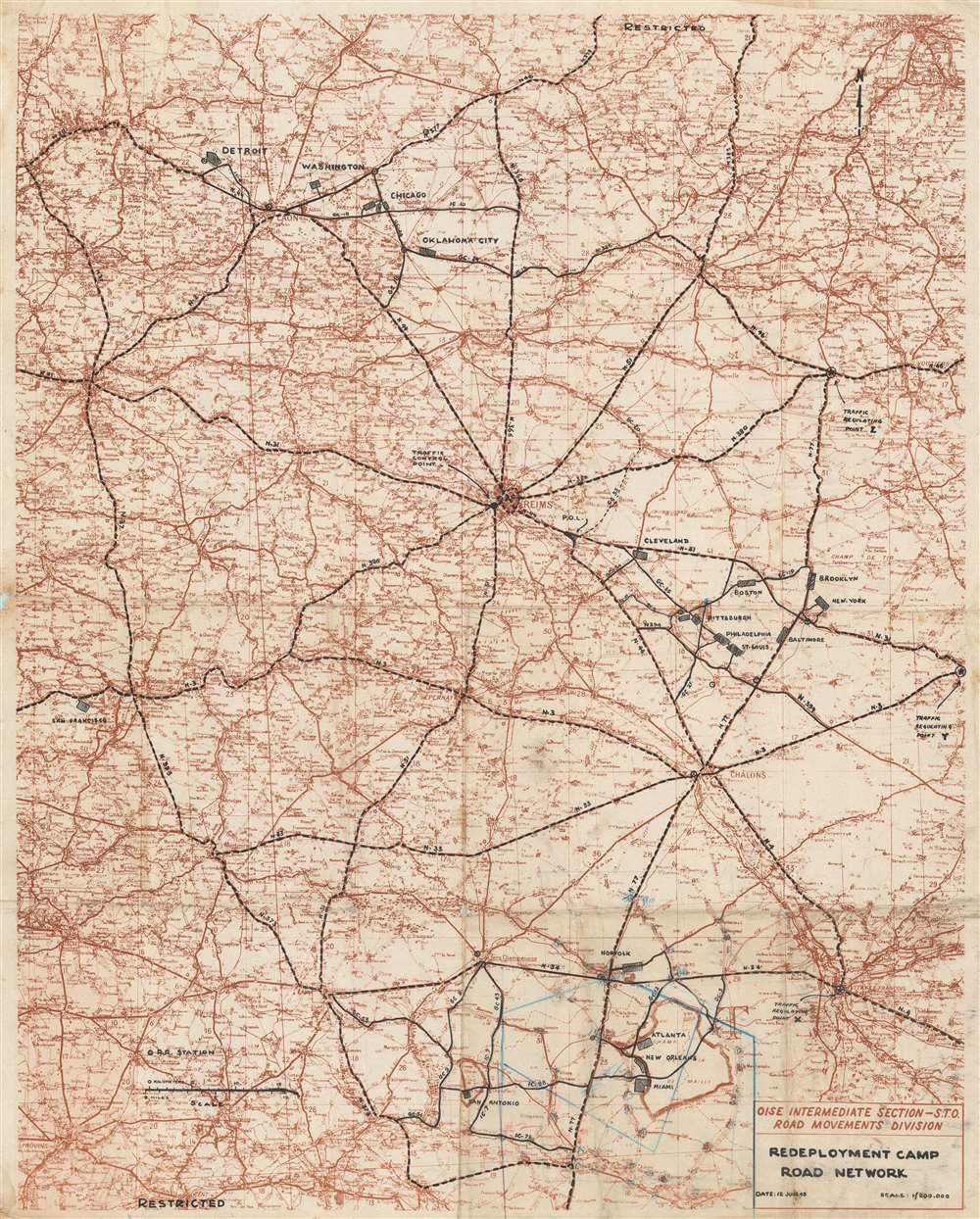This item has been sold, but you can get on the Waitlist to be notified if another example becomes available, or purchase a digital scan.
1945 U.S. Army Road Map of Reims, France and Army Redeployment Camps
RedeploymentCamp-roadmovements-1945$1,200.00

Title
Redeployment Camp Road Network.
1945 (dated) 26.75 x 21.5 in (67.945 x 54.61 cm) 1 : 200000
1945 (dated) 26.75 x 21.5 in (67.945 x 54.61 cm) 1 : 200000
Description
A 1945 record of a little-known chapter in World War II. This map details the network of 'city' redeployment camps established in Europe after Germany's surrender and the end of World War II in Europe. The Road Movements Division map of Reims, France, and its environs, tells the story of how millions of European theater American soldiers returned home. These 'city camps,' named for American cities, including Detroit, Norfolk, Oklahoma City, Cleveland, Pittsburgh, St. Louis, and Boston, appear as black boxes. Dashed black lines, representing roads, connect the camps and the major towns. Traffic control points and traffic regulating points are also labeled, which makes sense given that thousands of trucks would have been traveling these roads in the summer of 1945. Intriguing manuscript notations in blue pencil appear along the bottom border and surround the Atlanta, New Orleans, and Miami redeployment camps. Unfortunately, we have been unable to decipher the meaning of these markings.
Redeployment Camps
A series of redeployment camps sprang up immediately after the German surrender ended World War II in Europe. As the war in the Pacific was ongoing, American commanders were tasked with redeploying European units to the Pacific as quickly as possible. Within the first twelve months, Allied Command hoped to move over three million soldiers to the Pacific. Two systems of redeployment camps were organized. One, known as the 'city camps,' was organized under the Assembly Area Command around Reims, France, and were named after American cities, as can be seen from the current map. The second set of camps were named after popular cigarette brands, 'Camp Lucky Strike' for example, and were much closer to the actual ports of debarkation, where men and supplies would leave for either the United States or the Pacific. 'High point' soldiers, those who had seen a lot of combat, were given a chance to be discharged and return home. These men were removed from their units and reorganized into new units set to be disbanded. They were replaced with 'low point' soldiers, those who had not been in Europe for long or who had not seen combat, and who would be sent to the Pacific for the upcoming invasion of Japan. Hundreds of thousands, if not millions, of soldiers were waiting in these camps for their next assignment when the Japanese surrender ended the Pacific War. For these men, this meant that their ordeal was over and that they could look forward to home, rather than going on to fight what would have been the biggest, and likely bloodiest, battles of the war.Why Haven't I Heard About Redeployment Camps?
Minimal scholarship has been produced concerning these 'city camps.' Likely due to the celebration and commemoration surrounding the end of the war, the importance of these camps faded away after Operation Downfall, the planned invasion of Japan itself, became nothing more than a footnote of history. The critical role they would have played in providing the men and machinery needed to launch what would have been the biggest amphibious invasion in human history disappeared, and they became a mechanism for millions of soldiers to return home in a (mostly) organized way.Publication History and Census
This map was printed on a French road map, dated June 12, 1945, and created for the Road Movements Division of the Oise Intermediate Section. One example is cataloged in OCLC and is part of the collection at the New York Public Library.Condition
Good. Exhibits wear along original fold lines. Verso repairs to fold separations and stabilizations to folds. Exhibits loss at several fold intersections. Exhibits loss to left border. Blank on verso.
References
New York Public Library Map Div. 05-334. OCLC 59880457.

